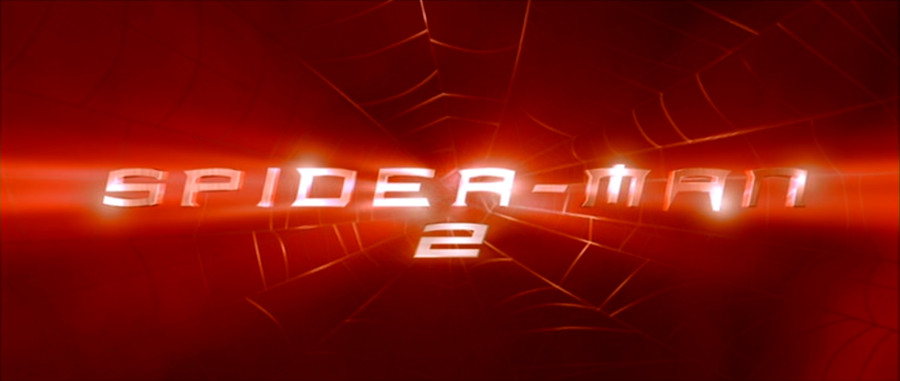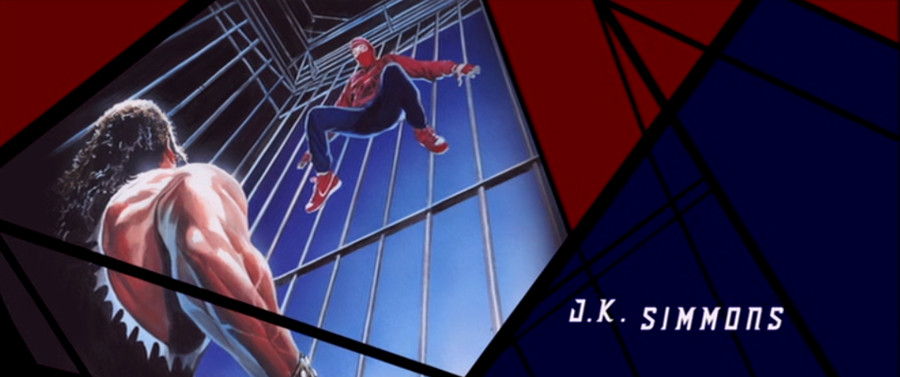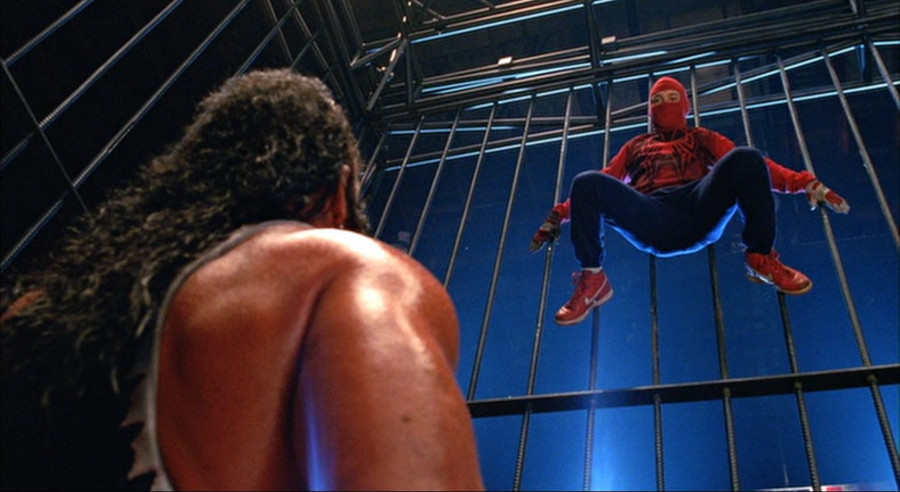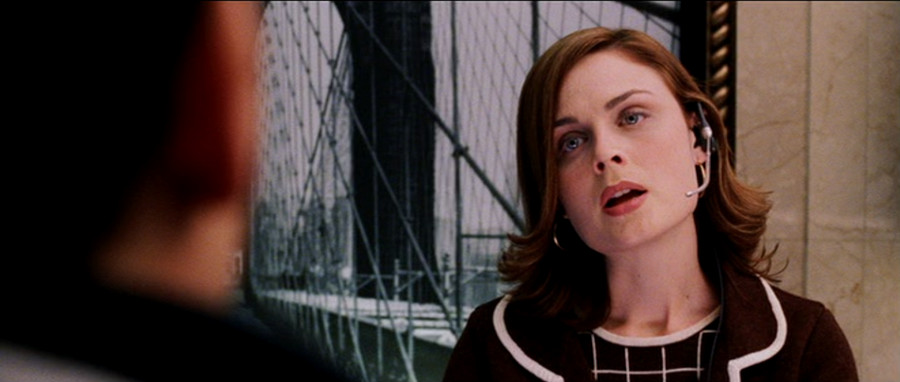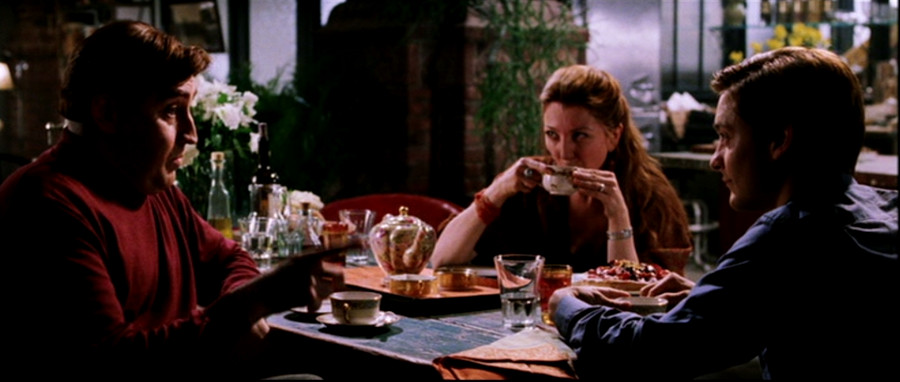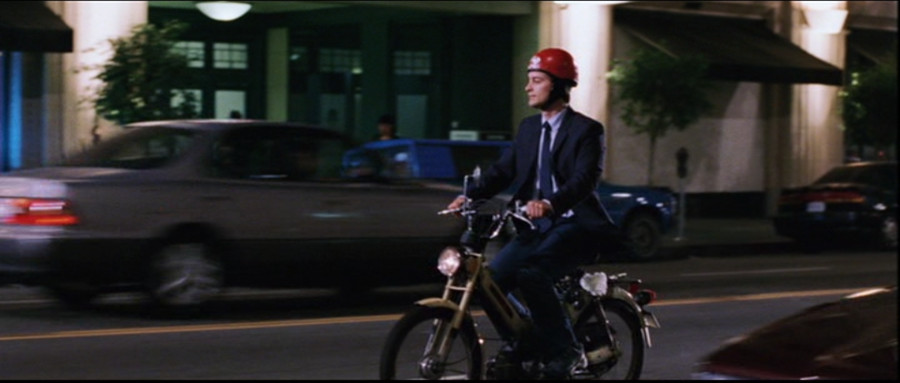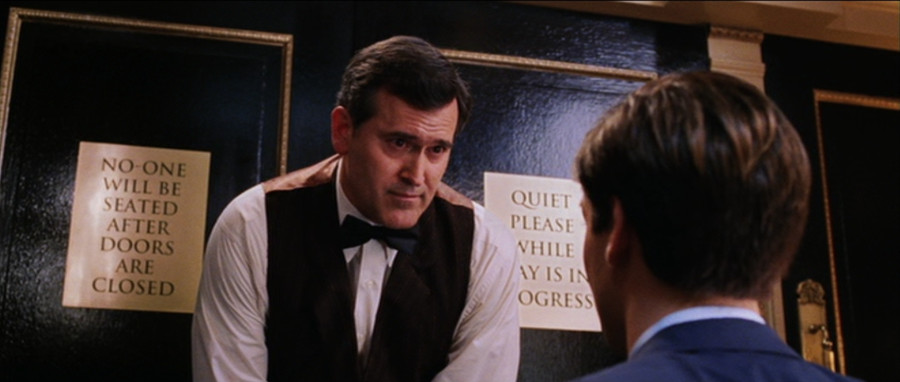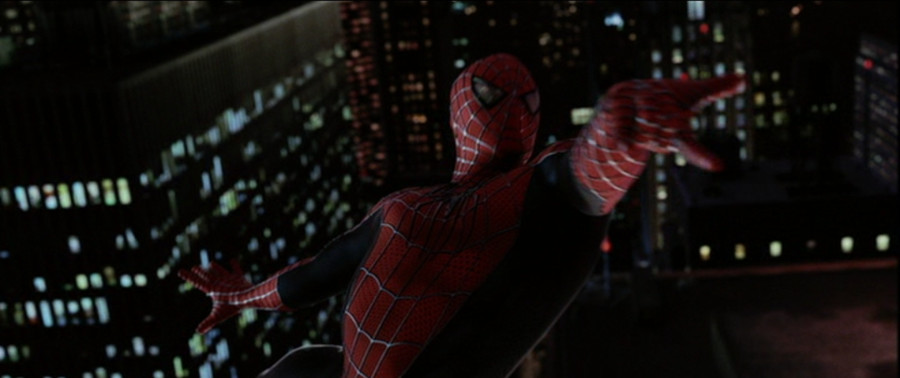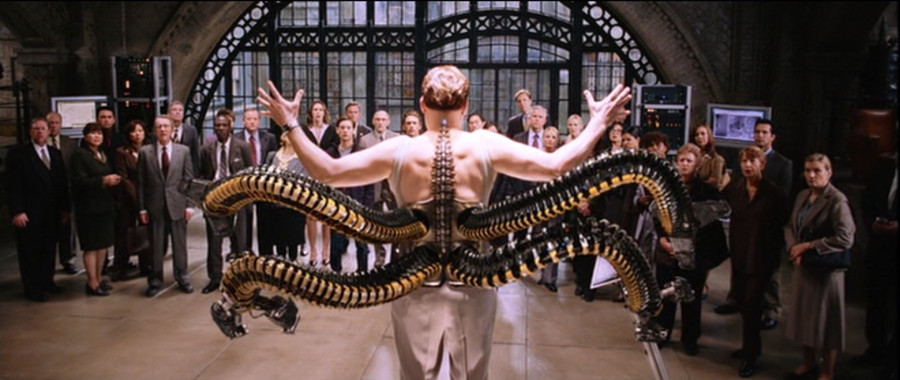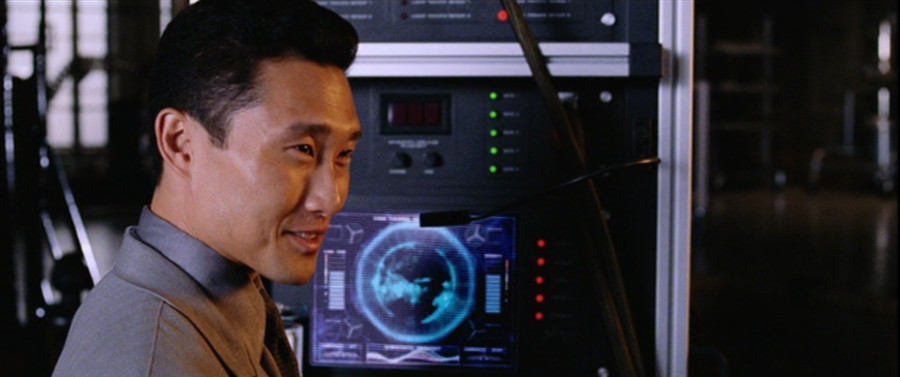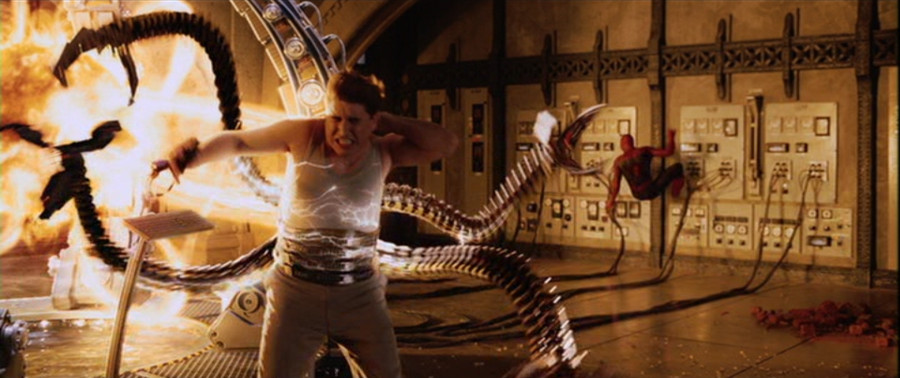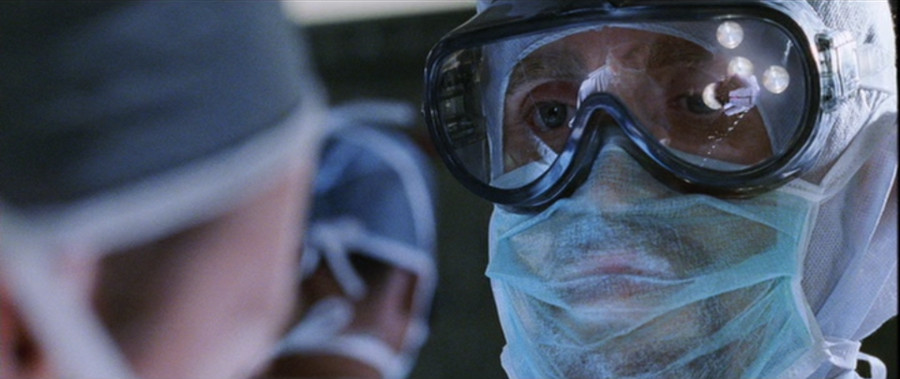
Yes, I know, it’s been forever since I did one of these, and even longer since I covered the first Spider-Man movie. But I’m going to try to do this again; let’s see if this leads me to resume duties on the website in general.
So the first Spider-Man film, directed by Sam Raimi and starring Tobey Maguire, was a smash hit, despite a number of flaws including cringe-worthy moments and plot beats lifted directly from previous superhero films. Despite its problems, it got the spirit of Spider-Man exactly right, that combination of thrilling action and soap-operatic melodrama bound together by the main character’s earnest appeal.
The sequel was, at least for a while, acknowledged by many as the best comic book adaptation/superhero film ever. More than ten years later, does it still hold up?
Let’s see.
Right off the bat, a technical note: the DVD starts with disclaimers about the commentaries not necessarily reflecting the views of Sony/Columbia in three languages. What the hell is in those commentaries that has them so worried?
The opening titles set the tone beautifully, retelling the story of the first movie quickly and economically through a series of gorgeous paintings by comics legend Alex Ross.
Compare the painting to the original scene from the first movie.
Ross’s paintings convey the essence of the sequences in question while also heightening the imagery in very comic-bookish ways (check out the increased foreshortening and the muscle definition on the painted version of the scene above), which I think helps the paintings convey the emotional impact of the scenes better than a simple frame-capture would.
Then the story opens with a close-up of Mary Jane’s face on a billboard. Wow, she’s like a super-successful fashion model! When did this happen?
Thus begins the opening sequence depicting a day in the life of Peter Parker, and man, is it a mixed bag. First, Peter is confronted with a crisis at work: pizzas must be delivered in 7.5 minutes or Peter will be out of a job. His boss has a “29 minutes or it’s free” guarantee, you see, so if Peter is late, not only does the boss have to eat the cost of the pizzas, but he loses a valuable customer, which I call bullshit on. The only reason to order eight pizzas from a pizza place 45 blocks away in mid-town Manhattan is to guarantee your pizzas will be free. This is a customer you can afford to lose.
Eventually, Peter decides (with two minutes to go) that he will make better time by changing into Spider-Man. He runs into an alley, changes clothes, and web-slings his way uptown, pausing to save a couple of kids from being run over by a truck, which is fine, but then the bit at the other end doesn’t make any sense.
We see the lobby of the law firm where he’s delivering the pizzas, and Peter Parker comes out of a broom closet in full view of the receptionist (played by TV’s Bones, Emily Deschanel).
It’s bad enough that he spends over 30 seconds fighting with the mops and brooms with seemingly no sense of urgency about meeting the deadline. But more to the point, wouldn’t the receptionist be kind of suspicious at seeing Spider-Man go into a broom closet and Peter come out? Do broom closets in New York commonly have windows? And how did Peter get back into his civilian clothes (including a down vest over a windbreaker) when we clearly saw that he was not carrying them with him when he was in costume?
You know, who cares, because Peter missed the deadline and he’s fired. He’s also fired from his position at the Daily Bugle, because he’s trying to sell artsy pictures of Central Park instead of the Spider-Man action shots that J. Jonah Jameson demands. But Peter has a Spider-Man shot in his back pocket that Jonah buys for not quite as much as Peter already owes the Bugle, so Peter is un-fired, but still behind on the day. And once again, the movie criminally underutilizes Elizabeth Banks as Betty Brant, Jonah’s secretary.
After a brief interlude with the soon-to-never-be-the-Lizard Dr. Curt Connors, where we learn that Peter is failing his classes and planning to do a paper on Dr. Otto Octavius, Peter visits his Aunt May (with the obligatory shot of the Olds Delta 88 Raimi uses in every film he directs), where she has a surprise birthday party waiting with Harry Osborne and Mary Jane.
Holy crap, all this is happening on his birthday? Seriously, Movie?
Anyway, Mary Jane is obviously still into Peter after he dumped her at the end of the first film. Harry Osborne even says, “She’s waiting for ya, Pete.” Which isn’t technically true, but we’ll get to that in a minute. Meanwhile, Harry has obvious hatred for Spider-Man, who Harry believes killed his father.
I’m not really a fan of James Franco, but he pulls off some interesting work in these films. He has to play on so many levels. He loves Pete, but also resents him because of his closeness to Spider-Man. He tries to appear self-confident, but is constantly trying to compensate for his own insecurity. Unlike Peter, who tries to make up for his own failings by working harder, Harry tries to buy respect with his family fortune, and always ends up even more disappointed and angry when it doesn’t work.
After the party, Peter notices that Aunt May has received an eviction notice. Peter worrying about Aunt May being able to pay her bills was a staple of the Lee/Ditko and Lee/Romita comics, and Rosemary Harris is great here, especially when she fiercely insists that Peter accept $20 as a birthday gift, because she can’t bear his pity.
Peter takes the trash outside and runs into Mary Jane, in a neat echo of a similar scene from the first movie. But it turns weird, when first she tries to get him to admit he loves her, then she says she’s got a new boyfriend that may be serious (putting the lie to Harry’s “waiting for ya” comment), then Peter impulsively promises to see the play she’s starring in. Because that fashion model thing was just for one billboard or something? The movie never makes clear exactly how her career works.
Peter finally goes back home to end this crapstain of a day, only to have his birthday money confiscated by his bullying landlord, Mr. Ditkovich (a nod to Steve Ditko, the original Spider-Man artist), because Peter is behind on the rent for his shoebox of an apartment.
And I’ve described this first fifteen minutes in such minute detail because these scenes are trying to do so many things at once: introduce new viewers to Peter and his world, catch up returning viewers on what has happened in that world since the first film ended, introduce us to all the major characters (save one) and spell out Peter’s relationships with them. But it also pounds on one theme over and over in every single scene: no matter how cool Peter’s superpowers are, they’re kinda’ fucking up his life. Okay, Movie, I get it! Jeez!
So the next day or so, Peter goes to visit Dr. Otto Octavius (Alfred Molina), the science genius he plans to write a paper on. Turns out, Octavius’s nuclear fusion research is funded by OsCorp, so Harry gets to play big man benefactor by making Octavius take the meeting, and for once, Peter can’t refuse. Octavius is clearly unhappy to have this interruption forced on him, but he recognizes Peter’s name as Dr. Connors’s student and next thing you know, he’s acting like Peter’s life coach, not just talking science, but introducing Peter to his wife and having him stay for dinner.
Peter is worried that the fusion reaction might run out of control, but Octavius dismisses his concerns and is much more interested in telling Peter how to get girls. I don’t know that I’ve ever seen a movie where the villain is introduced as such a genuinely nice and interesting guy, unless the movie was going for a surprise third-act reveal, in which we learn the villain was just pretending all along. That’s not the case here.
Anyway, Octavius tells Peter, “If you want to get a woman to fall in love with you, feed her poetry.” And just like that, Peter’s in a laundromat reading “The Song of Hiawatha” and discovering that his Spider-Costume has turned the rest of his laundry pink. Because Peter’s been Spider-Man for over two years now, but this is apparently the first time he has washed his outfit. Also, why is he reading poetry? Mary Jane has already fallen in love with him; the only reason they are not together now is by his choice. And it’s not as if he lacks other options for companionship. Betty Brant, the secretary at the Bugle, seems to have a soft spot for him, and Mr. Ditkovich’s daughter has an obvious head-over-heels crush on him. And she’s pretty cute in a bug-eyed, sweaty way.
I know that people sometimes do things for emotional reasons that don’t make logical sense, but I really don’t get where Peter’s going with this. But I do know where Peter’s going next, and that’s to MJ’s play. She’s starring in a production of The Importance of Being Earnest, because nothing’s too on-the-nose for a Sam Raimi joint.
Peter puts on a suit, gets on his scooter and heads for the play, which, fittingly enough for a work by Oscar Wilde, is apparently being performed in England.
They have obviously flipped the footage in order to toy with the screen direction, which is a subject for a formal film theory study that I have neither the time nor expertise to really indulge in now. Suffice to say that his trip to the theater is interrupted by a high-speed chase involving two crooks in a huge black Lincoln convertible. In what is our first real action sequence of the movie (not counting the very brief web-slinging heroics in the pizza delivery scene), Peter uses his webs as weapons and takes the thieves’ car after they destroy his scooter.
Alas, despite his promises to the contrary, he arrives late to the theater and is refused entry by a very familiar-looking usher (Bruce Campbell playing a different cameo character than he played in the first film).
Peter waits outside for MJ to come out after the play is over, but she ends up in the arms of another dude in front of a sign that says, “J. Frazier is especially effective!“, a shout-out to special effects director John Frazier. (another sign says “Wil Madoc Rees is a perfect Bon Vivant,” a shout-out to production illustrator Wil Madoc Rees).
Rather than say hello or confront them, however, Peter follows passing police cars apparently on their way to another crisis, when this happens…
Webbus Interruptus. Peter falls what looks like a couple hundred feet to smash some conduits on a roof. Even worse, Peter seems to have lost his other powers, too: his strength, his agility, his ability to cling to walls. Everything except his ability to soak up incredible amounts of damage. He ends up having to make an embarrassing ride down in an elevator in full costume (unlike the pizza delivery adventure, his civvies don’t appear to have made the trip with him this time), awkwardly sharing the ride with snarky Hal Sparks (former host of Talk Soup).
Peter tries to apologize to MJ the next day, but ends up confessing his secret identity to an empty line when he doesn’t have enough change to keep the payphone connection open. You know, in case the first 15 minutes hadn’t pounded the “Spider-Man is ruining Peter’s life” drum hard enough yet.
And now, over 30 minutes in, it’s finally time for the throat-clearing to stop and the actual plot to begin. Dr. Octavius is going to attempt his first fusion reaction, and of course, he’s going to do it live in front of an audience of press and big-wigs in his wide-open, completely unshielded lab/apartment. But don’t worry, nothing can go wrong because he is a scientist. The special apparatus he’s going to use to keep the reaction from going out of control?
This, baby.
A set of special cybernetic tentacles which allow him to, I don’t know, moderate the reaction or something. They are controlled by a special artificial intelligence program that connects directly to his central nervous system, and there’s a special chip that makes sure he stays in control of the arms and not vice-versa.
So he starts the reaction with the help of his wife and his assistant, played by Daniel Dae Kim from Lost.
And it is a complete success, at least long enough for Octavius to whisper, “The power of the sun in the palm of my hand,” which isn’t megalomaniacal or anything. And faster than you can say “hubris,” it all goes wrong. The reaction goes out of control. The apartment is destroyed. Harry futilely yells, “I’m in charge here! It’s my money!” which the miniature sun is apparently completely unimpressed by, because it nearly kills him before Spider-Man saves his life. Mrs. Octavius is killed by a flying shard of glass, which distracts Octavius long enough to get him zapped by his own creation.
Spider-Man manages to shut it down, but the experiment is a failure, Octavius is critically injured, and Harry’s position as heir to his father’s company is in jeopardy. Harry, of course, blames Spider-Man.
At the hospital, doctors prepare to cut the mechanical arms off of Octavius as a first step toward repairing his spinal damage. But as they start the saw, what is that tell-tale reflection in the doctor’s goggles?
See you next time for part 2.

